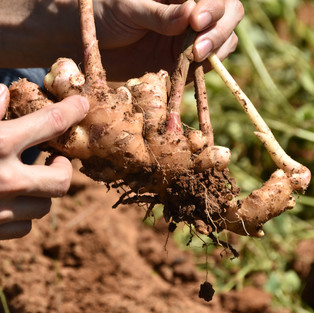Planting Seeds: Aungban, Kalaw, and Inle Lake, Myanmar
- tangio
- Dec 16, 2019
- 9 min read
The VIP Ride
The Aung Mingalar Highway Bus Station in Yangon is a total clusterfuck—in the most remarkable way. After our quick trip down to Hpa-An and Golden Rock, we ended up here again to meet up with our friend Tomo to take the overnight bus from Yangon up to the industrial city of Aungban, located in Shan State in eastern Myanmar. Having heard about these infamous overnight “VIP buses” before, we were excited to take our first one.
There appears to be no central organization whatsoever at the massive bus station that stretches over several blocks on the far north end of the city (45-60 minutes away from the city center by car). There are hundreds of disparate private bus companies running innumerable routes out of Yangon, all operating their own ticket counters and booking system, and each with their own meeting spot to catch their bus. There are no bay or gate numbers for the bus or company location. In between rows of giant buses trying to come in and out, tuk tuks and food stalls randomly park themselves right in the path of a bus trying to reverse. Local cooks serve up noodle soups, and their patrons sit down on small plastic stools to eat them, within the cloud of another’s exhaust fumes.

The funniest part is, every bus is scheduled to leave on the hour. Our bus was scheduled to depart at 8:00pm. By 7:45pm, the three of us were settled in our surprisingly comfortable and roomy seats, playing with the individual entertainment systems in front of us (the video game about parking was really riveting) and bemused by how far back our seats leaned for sleeping (indeed, they went so far back that Karen was practically sleeping in Tomo’s lap in the seat behind her!). Everyone was ready to go by 8:00pm.
But then, we waited. About twenty other large buses in our small area of the parking lot were all also trying to get out at 8:00pm; everyone tried to reverse at once into the same space, creating the inevitable mess of slamming brakes, honking, and 100-point turns as we all came within inches of hitting each other. Meanwhile, the 9:00pm bus operators were also trying to come in to get ready and park into their spots. Hour after hour of doing this every single day, and no one thought that maybe taking turns or spacing out each departure by 5 or 10 minutes would be a good idea. The operations manager in Karen was about to explode with inefficiency overload. The three of us sat in the back of our bus, staring out the window as we inched forward one minute, then pulled back into our spot to make room the next minute, and just laughed. Since it took us about 45 minutes before we were on the road and out of this “traffic,” we would have gladly been the 8:45pm bus!
Fortunately, the rest of the ride was not so hilariously frustrating, as we had mostly smooth driving and a very nice and professional bus attendant (well, except when he asked us whether we wanted tea or coffee ready for us in the morning when we arrived—a very nice gesture—and when we all said tea, he replied with, “Well, we only have coffee”……). As all of these long bus routes go, we stopped twice on the 10-hour ride, for bathroom breaks and midnight snacks. On one of the stops, we were all in squat toilet stalls when a now-expected blackout hit, and we had to find each other in the dark again. Just another 2:00am in Myanmar.
Agricultural Aungban

It wasn’t too much brighter when we arrived in Aungban at sunrise. We were unique visitors to Aungban, which serves as the industrial trading center for the agricultural belt of Myanmar. Large trucks load up here at wholesale markets, bringing locally grown cabbage, garlic, potatoes, ginger, tea, and other crops to the nation’s population centers in Yangon, Mandalay, and beyond. In other words, Aungban is abuzz with locals conducting commerce, but not with tourists. We were there because Tomo, along with a few local and expat business partners, has been in Myanmar for the past two years working on Green Eastern Agri, a ginger export start-up, and their factory, test ginger farms, and partner farmers are all located near Aungban. (Tomo himself is not from Myanmar, but has worked significantly in Southeast Asia before, most notably in Singapore and Indonesia.) Though it was not ginger harvesting season (which is January and February), we were interested in the unique opportunity to accompany a friend to see their processing facility, visit some farms, and learn about the operation in general, while getting a taste for what it’s like to conduct business in Myanmar.
Before we did so, though, we needed a nap from our “sleeper” bus, in which none of us got enough sleep. We took a quick ride to the company’s rented house near the center of town and settled into a spacious, no-frills building with three mosquito-net-covered twin beds, a detached bathroom and kitchen, and scant other furniture, and napped for the next couple hours. For a late breakfast, Tomo introduced us to and we devoured several bowls of “Shan noodles,” a delicious Chinese-influenced dish unique to Shan State that is essentially very sticky, glutinous rice noodles topped with some meat, scallions, and crushed peanuts.
Then, we were off to inspect ginger. We first checked out the company’s warehouse, built just last year and custom-designed for the assembly-line that brings in freshly-harvested ginger from around the region to wash, dry, sort, grade, and pack up. During season, about 40 workers from the local village come to the warehouse to work every day.

Tomo’s company is trying to create a market for Myanmar-grown ginger in America, which could pose exciting opportunities for Myanmar if successful. However, there are meaningful obstacles they have to overcome before this becomes something you can find in your local American grocery store. Foremost is the issue of supply; current farming inputs and practices in Myanmar (at least for ginger) do not yet create consistent yield and quality that buyers can rely on. The company is trying to improve this by starting to train farmers in everything from seed spacing to fertilizer and inputs, but smallholder farmer education, let alone actual behavior change, is a slow and long process.
Without consistent volume, the second issue of logistics becomes ever more difficult. Negotiating prices for a refrigerated cargo container to ship across the world is hard when you can’t guarantee how much space you will need or when you may be able to send it; having been closed to the world for so many decades also means that there are few, if any, existing trade routes from Myanmar to the U.S., so exporters need to try to hop on existing shipments via Bangkok or Singapore, adding both time and money to the route. Because of this, it costs an exorbitant amount of money to ship one refrigerated container of ginger from Yangon to the East Coast (we were told that most ginger found in America is from China, which arrives in West Coast ports, so there is more of a market for alternative ginger on the East Coast).

Finally, quality control for the picky and very specific U.S. market can be difficult. U.S. buyers demand that the ginger be completely free of dirt, which makes sense from an agricultural safety perspective, but as a root with many nooks and crannies, ginger takes a lot of work to clean, adding to processing costs. They also want the perfect size and shape (the size of a large hand palm—even though end-customers, whether they’re restaurant cooks or grocery store goers, ultimately break up ginger anyway and never use an entire ginger that large), which rules out most of the ginger brought into the Green Eastern Agri factory. Indeed, after inspection, only about 20% or less is exportable, with 80% being sent to the regional retail markets for sale locally.

After we visited a couple actual ginger farms out in the countryside, coming across field workers who were weeding the rows by hand (which only happens three times a season), we realized that supply issues and logistics probably pale in comparison to the potential instability in the region, the lack of institutional systems in the industry, and the fact that many domestic farmers and workers had once lost incentive to work during Myanmar’s closed military rule; re-adopting that mindset is perhaps an even longer and slower process. Lying beyond the colorful crop fields that we drove past, we knew that civil war still lingers in this same state, where the Shan, the Pa’O, and other ethnic groups are still sporadically sparring with the state and military for their autonomy. Against this backdrop, we can appreciate that growing consistent, chemical-free ginger of the right size and quality is not the highest priority; sometimes, any ginger at all is good enough.
It is admirable for Tomo and his team to push on and try to make this export business work, despite the many challenges. It is not easy, but the potential upside is, for now, worth the uphill battle. That night, after visiting the farms and the local wholesale markets, we, Tomo, and one of their employees enjoyed BBQ Myanmar-style, wherein we simply point to various piles of raw meat, seafood, and vegetables, in return for flavorful, freshly-grilled skewers, including greens, garlic, and ginger [presumably] plucked from the fertile and opportunity-filled lands around us.
Kalaw to Inle Lake
Our jaunt through the Myanmar farmland was not over. Over the next two days, we joined a group to hike 35 km / 22 miles from the nearby town of Kalaw to Inle Lake, the famous fishing and recreation lake in Shan State that actually sees quite a bit of tourism from both local Myanmar people and international visitors. Our group of eight comprised the two of us, two Irish girls, and four Dutch travelers, under the fun and spirited guidance of “Momo,” our superb Myanmar guide. (The Dutch are everywhere in Southeast Asia; we wonder if anyone is still living in the Netherlands right now!)

Swapping travel tips, life stories, and really good Myanmar food with this group for two days was an incredibly fun way to see more of rural Myanmar. The hike was not hard, but steady, winding up and down through rolling fields of crops planted in grids, bursting with colors and textures—multiple shades of green from corn, ginger, rice, and cabbage; tan from wheat or freshly-harvested rice; bright yellow from the flowers of rapeseed. Water buffalo and Myanmar cows (which have a distinct hump on their backs that distinguish them from the cows we’re accustomed to) stood watch over the fields, and often helped haul the day’s harvest back to the village come evening. It was hot, but bearable (not Yangon-hot), and we sought respite in the passing villages of the ethnic Pa’O people, getting a slim view of their traditional lifestyle, having lunch in the home of one, and staying overnight for dinner and breakfast in another.
At night after our first full day of hiking, Momo proved that he truly had the full package of a proper tour guide—by serenading us with acoustic guitar and smooth vocals, and getting all of us to sing popular campfire songs together around, well, a campfire. We couldn’t decide which was funnier: hearing the Myanmar version of Shaggy’s “Wasn’t Me” (will full-on lyrics in Myanmar), or watching a bunch of Dutch people enthusiastically croon about West Virginia in “Country Roads.”
That night, all eight of us shared one room in the homestay of a local village family, sleeping next to each other on small futon mats on the floor, enduring cold bucket showers if we wished, but most of all, enjoying surprisingly good and abundant food cooked by the family (“surprising” not because Myanmar food hasn’t been good, but because this trek was so inexpensive, even relative to other tours and prices in Myanmar, that we had not expected much from the meals!).

While our interaction with the family was limited and they did not speak any English, we had the privilege of hanging out with one of the daughters as she got ready for school in the morning, watching her pound thanaka bark against a slate slab to create the make-up and apply it to her face. (As a reminder from two posts ago, thanaka is a yellowish cosmetic unique to Myanmar that also serves as sun protection and is applied in beautiful circular and floral designs across the face and arms.) After getting ready herself, she then offered to apply it on the rest of us; several of us took her up on it, including Karen. The start of our route that morning passed the village school, where we watched the daughter join several dozen other children from the surrounding village, all dressed in school uniform and made up in thanaka. We bid them farewell, hiking off with thanaka of our own.

The expansive views of rustic farmland and dramatic mountains continued this second day as we made our way down to Inle Lake. Inle Lake is famous for the temples that dot its shores, the floating gardens and stilt villages of the surrounding ethnic groups that literally sit on the lake, and the unique fishing methodologies of the Intha people, who paddle with their feet, leaving both hands available for handling a fish net. The trek wrapped with a relaxing long-tail boat ride through both rain and rainbows as we made our way across the lake, to the town of Nyaungshwe on the north side of Inle Lake.
We felt fortunate to have had two different but complementary glimpses into the important agricultural life of Myanmar—the local perspective from the small business point of view, and the tourist perspective from the guided trekking tour. Whether in active ginger fields or along lazy lake shores, it was clear that Shan State is starting to open up, modernize, and rebuild even as turmoil still exists within its borders—optimistically, but gingerly.
Karen & Michael
Aungban, Kalaw, and Inle Lake, Shan State, Myanmar, November 2-4, 2019
Click though slideshow below for more pictures





















































Comments